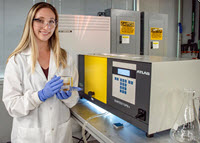
When an oil slick is exposed to sunlight, photo-oxidation processes break the oil down and incorporate oxygen into the petroleum molecules. When the incorporated oxygen reaches a certain amount, the petroleum can dissolve in water and potentially affect marine organisms and ecosystems. Sydney Niles is investigating how photo-oxidation alters the oil’s molecular composition and if that process forms toxic water-soluble oil compounds that may affect environmental and public health. Her research may help the response community better understand oil’s molecular-level effects on ecosystems and communities and inform future clean-up and restoration efforts.
Sydney is a Ph.D. student with the Florida State University Department of Chemistry and Biochemistry and a GoMRI Scholar with the project The State-of-the-Art Unraveling of the Biotic and Abiotic Chemical Evolution of Macondo Oil: 2010-2018.
Her Path
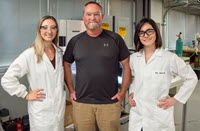
As a child, Sydney was curious about how things work and enjoyed finding the answers in her science classes. She discovered a love for chemistry in high school, when she learned that chemical reactions can explain the molecular-level activities behind phenomena such as color changes in oxidized metals. As an undergraduate chemistry major at the University of Michigan, she gained lab experience while working on a Parkinson’s study and later in an environmental research lab focusing on analytical chemistry. She was amazed that scientists could use electron microscopes and analytical techniques to clearly observe micron-size aerosol particles and determine which elements were present. The experience sparked her desire to use analytical chemistry to benefit the environment and public health.
Sydney joined Dr. Alan Marshall’s research group at Florida State University as a graduate student hoping to work with the National High Magnetic Field Laboratory’s mass spectrometers (instruments that can measure the mass of individual compounds). She began working more closely with Dr. Ryan Rodgers after deciding to focus her research on petroleum applications.

“Growing up in Michigan, I loved being in nature and taking summer trips to the Great Lakes, where we have beautiful beaches and clean, clear water. I couldn’t imagine an event like Deepwater Horizon happening to the ecosystems I enjoyed back home,” said Sydney. “I was initially wary about working with petroleum, as I have always been passionate about wildlife and taking care of the planet. However, I realized Dr. Rodger’s group was also focused on environmental applications involving petroleum, and I became passionate about using the tools at my disposal to contribute to GoMRI’s research goals.”
Her Work
Sydney mimics in situ oil photo-oxidation in the lab using a solar simulator and oil collected directly from the Macondo well during spill response. She analyzes the oil before and after irradiation using Fourier-transform ion cyclotron resonance mass spectrometry (FT-ICR MS). This process describes oil samples on a molecular level and allows her to compare oil compounds present before and after sunlight exposure. Since molecular composition is closely tied to oil’s tendency to aggregate and form emulsions and deposits, identifying the compounds present after irradiation can help determine how petroleum will behave in the environment. She conducts similar analyses on oil sheens and tar balls collected from oiled beaches and compares them to lab-irradiated samples. She found that lab-irradiated samples strongly resemble those collected from oiled beaches but do not resemble lab-generated samples created using biodegradation. This suggests that sunlight created oxygenated compounds identified in field samples rather than processes associated with oil-degrading bacteria.
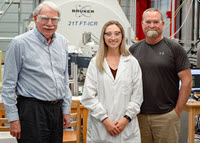
So far, Sydney has observed that photo-oxidation forms oxygenated oil- and water-soluble compounds that are not present in the samples prior to irradiation. Some of the oil-soluble compounds act like surfactants that cause oil slicks to swell with seawater and form strong, mousse-like emulsions. The emulsions’ oil- and water-soluble components are difficult to separate, which can impede clean-up efforts. “Typically, the densities of oil and water are different enough that you can easily scoop up an oil layer without disrupting the water layer,” she explained. “Separating the oil and water is much more difficult if an emulsion has formed (imagine shaking up oil and vinegar dressing and then trying to isolate the two layers). These mousses can be several feet thick, and the incorporation of water makes them heavier and increases the volume of material that needs to be cleaned up.” While both oil- and water-soluble compounds contain potentially toxic hydrocarbons, water-soluble compounds are of specific interest to Sydney’s research because they travel more freely throughout marine ecosystems.
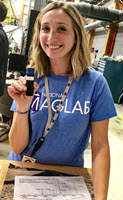
Sydney will test the toxicity of water-soluble compounds formed through the irradiation process using microtox bioassays, adding bioluminescent bacteria to a water sample containing the irradiated compounds and measuring luminescence at given time points. Luminescence will decrease when bacteria are killed by toxic compounds, allowing her to correlate luminescence with toxicity in the sample. “Petroleum hydrocarbons have known toxicity, and we are curious to see if they are released into the environment as water-soluble compounds after photo-oxidation,” she explained. “Understanding how different weathering processes contribute to the oil’s chemical and physical changes in the environment is the best way to plan better clean-up strategies for future spills.”
Her Learning
Sydney’s experiences conducting GoMRI research often reminded her of why she came to love chemistry. She recalled an experiment that placed dark brown oil into a solar simulator for several days, transforming it into a light brown fluffy emulsion with a peanut butter consistency. She viewed the samples in the FT-ICR and saw dramatic changes in the oil molecules after photo-oxidation. “These results were just as fascinating to me as my high school chemistry class, where a reaction represents how molecules change and a physical change is also observed,” she said.
Her Future
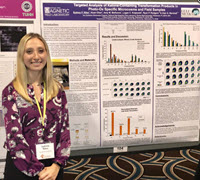
Sydney hopes to continue researching petroleum and the environment with an industry or at a national lab. She suggests that students considering a scientific career should participate in undergraduate research before pursuing graduate school, “Research is very different than classes, so make sure you like doing research before applying to graduate school.” She explains that finding a research project that sparks true passion in you is the best motivator for a science student. “If you are doing something you feel is important for society or the environment, you will be much more motivated in the lab,” she said. “Dr. Rodgers is very passionate about how our research can impact human health, animal health, and the environment, which helped me to see the bigger picture every step of the way.”
Praise for Sydney
Dr. Marshall recalled that Sydney immersed herself in the research from the moment she arrived at Florida State University. He describes her as a multi-tasker who often works on several projects at once, including mastering the National High Magnetic Field Laboratory’s custom-built FT-ICR MS. Her research has led to 14 poster and oral presentations at major scientific conferences, and her Ph.D. dissertation promises to yield multiple journal articles. “Her first paper, soon to appear in Environmental Science & Technology, provides definitive evidence that ketones and aldehydes generated in weathered petroleum essentially derive completely from photo-oxidation, not biodegradation,” he said.
The GoMRI community embraces bright and dedicated students like Sydney Niles and their important contributions. The GoMRI Scholars Program recognizes graduate students whose work focuses on GoMRI-funded projects and builds community for the next generation of ocean science professionals.
By Stephanie Ellis and Nilde Maggie Dannreuther. Contact sellis@ngi.msstate.edu for questions or comments.
************
The Gulf of Mexico Research Initiative (GoMRI) is a 10-year independent research program established to study the effect, and the potential associated impact, of hydrocarbon releases on the environment and public health, as well as to develop improved spill mitigation, oil detection, characterization and remediation technologies. An independent and academic 20-member Research Board makes the funding and research direction decisions to ensure the intellectual quality, effectiveness and academic independence of the GoMRI research. All research data, findings and publications will be made publicly available. The program was established through a $500 million financial commitment from BP. For more information, visit https://gulfresearchinitiative.org/.
© Copyright 2010-2019 Gulf of Mexico Research Initiative (GoMRI) – All Rights Reserved. Redistribution is encouraged with acknowledgement to the Gulf of Mexico Research Initiative (GoMRI). Please credit images and/or videos as done in each article. Questions? Contact web-content editor Nilde “Maggie” Dannreuther, Northern Gulf Institute, Mississippi State University (maggied@ngi.msstate.edu).
